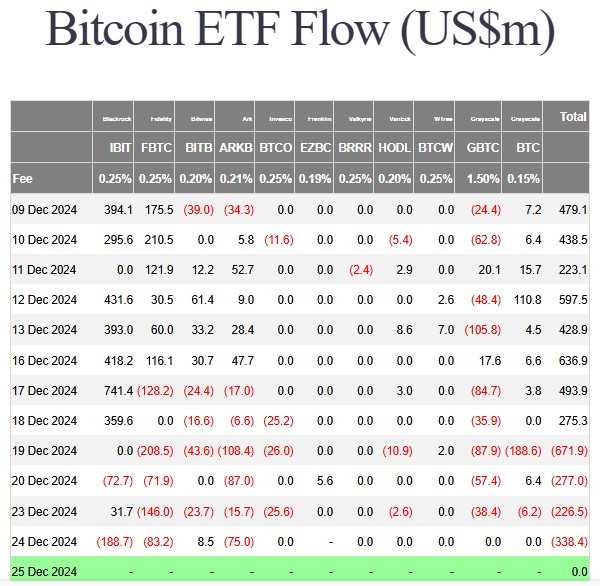
KEY POINTS
- The biggest losses were logged by Fidelity's $FBTC and Grayscale's $BTC ETFs
- Institutional entry into the crypto space surged significantly since the approval of spot Bitcoin ETFs
- Some crypto users are concerned that $BTC ETFs may have caused the coin to lose its original narrative
U.S.-listed spot Bitcoin exchange-traded funds (ETFs) had significant and consecutive inflows earlier this month, but a few days before Christmas, the funds started losing steam and suffered outflows reaching $1.5 billion through Christmas Eve.
Data from Farside Investors shows that from Dec. 19 through Dec. 24, U.S. spot BTC ETFs saw $1.512 billion in outflows, led by Fidelity's FBTC and Grayscale's BTC.
The outflows were recorded even when Bitcoin and several major altcoins saw some gains on Christmas Eve, triggered by hopes from the crypto community that the world's largest cryptocurrency by market cap will climb before the new year.

The Year of Institutional Bitcoin Through Spot $BTC ETFs
Even as Bitcoin ETFs are flowing outwards post-Christmas, the funds have had mostly wonderful year, seeing outflows here and there, but most of the time reaping gains in what could be the biggest story of crypto in 2024.
Stack Holder, a prominent figure in the crypto space, said Wednesday that "2024 was year one of institutional Bitcoin." Indeed, this year triggered an influx in institutional interest in crypto, but it wouldn't have been achieved without the approval of spot BTC ETFs.
2024 was year one of institutional Bitcoin.
— Stack Hodler (@stackhodler) December 25, 2024
The year that Bitcoin truly established itself as a must-own asset.
But 2025 will take things to a new level.
The ETFs are the superhighway that allow trillions of dollars of capital to flow into Bitcoin.
But the greatest ETF launch… pic.twitter.com/VooQHNkJPx
Some industry observers and experts are already expecting things to accelerate in 2025, especially with the entry of a new administration that has presented itself as pro-crypto and pro-innovation.
Did Bitcoin Lose Its Way Due to Spot $BTC ETFs?
While many investors in Bitcoin ETFs are hopeful that the outflow streak will end soon and inflow streaks will drag longer in the coming year, there is concern about whether the funds actually led to centralization – the ultimate taboo in Bitcoin's core narrative.
Commenting about the entry of institutions into the Bitcoin space, one crypto user on X said that BTC will only surge further as more traditional financial firms jump into the market as driven by interest in spot BTC ETFs, the digital currency's core has been corrupted.
"You're not wrong but Bitcoin lost its original narrative! And now is becoming more and more centralized!" the user argued.
The BTC whitepaper made it clear that the world's first crypto asset should be decentralized, meaning control is distributed across different teams or divisions instead of a focal power.
However, it has also become clear since the entry of spot BTC ETFs that huge institutions have become more involved in the coin, including ETF issuers BlackRock and MicroStrategy, the world's largest corporate holder of Bitcoin.
Martin Hisboeck, head of research at the Uphold exchange, previously said that the approval of ETFs made Bitcoin "just another asset in the army of financial planners wishing to improve their Sharpe ratio," which compared returns and risks in an investment.
Meanwhile, Bitcoin remains significantly down from its all-time high above $108,000 before the holidays. As of early Thursday, the coin is trading in the $98,000 lows and has had a very volatile price movement in recent days.







